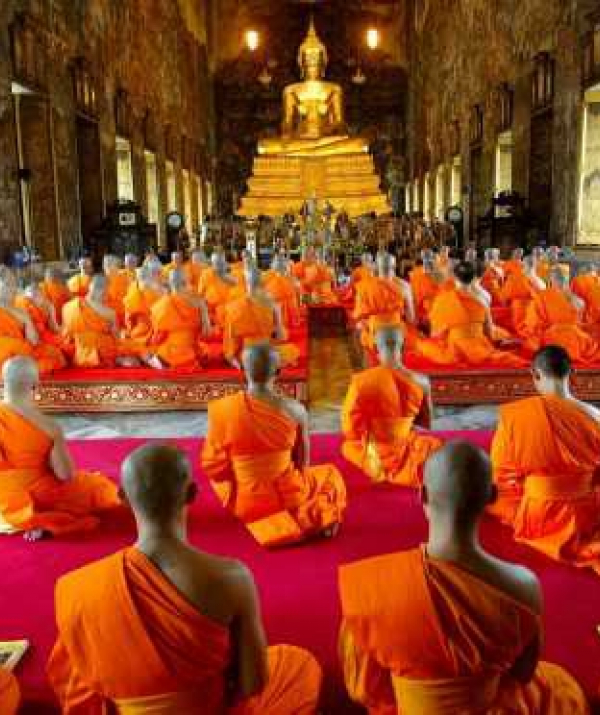Hãy lặng lẽ quan sát những tư tưởng và hành xử của bạn. Bạn sâu lắng hơn cái tâm thức đang suy nghĩ, bạn là sự tĩnh lặng sâu lắng hơn những ồn náo của tâm thức ấy. Bạn là tình thương và niềm vui còn chìm khuất dưới những nỗi đau. (Be the silent watcher of your thoughts and behavior. You are beneath the thinkers. You are the stillness beneath the mental noise. You are the love and joy beneath the pain.)Eckhart Tolle
Như đá tảng kiên cố, không gió nào lay động, cũng vậy, giữa khen chê, người trí không dao động.Kinh Pháp cú (Kệ số 81)
Khó khăn thách thức làm cho cuộc sống trở nên thú vị và chính sự vượt qua thách thức mới làm cho cuộc sống có ý nghĩa. (Challenges are what make life interesting and overcoming them is what makes life meaningful. )Joshua J. Marine
Con người chỉ mất ba năm để biết nói nhưng phải mất sáu mươi năm hoặc nhiều hơn để biết im lặng.Rộng Mở Tâm Hồn
Nếu muốn đi nhanh, hãy đi một mình. Nếu muốn đi xa, hãy đi cùng người khác. (If you want to go fast, go alone. If you want to go far, go together.)Ngạn ngữ Châu Phi
Nếu muốn người khác được hạnh phúc, hãy thực tập từ bi. Nếu muốn chính mình được hạnh phúc, hãy thực tập từ bi.Đức Đạt-lai Lạt-ma XIV
Không có ai là vô dụng trong thế giới này khi làm nhẹ bớt đi gánh nặng của người khác. (No one is useless in this world who lightens the burdens of another. )Charles Dickens
Học vấn của một người là những gì còn lại sau khi đã quên đi những gì được học ở trường lớp. (Education is what remains after one has forgotten what one has learned in school.)Albert Einstein
Hạnh phúc chân thật là sự yên vui, thanh thản mà mỗi chúng ta có thể đạt đến bất chấp những khó khăn hay nghịch cảnh. Tủ sách Rộng Mở Tâm Hồn
Để có đôi mắt đẹp, hãy chọn nhìn những điều tốt đẹp ở người khác; để có đôi môi đẹp, hãy nói ra toàn những lời tử tế, và để vững vàng trong cuộc sống, hãy bước đi với ý thức rằng bạn không bao giờ cô độc. (For beautiful eyes, look for the good in others; for beautiful lips, speak only words of kindness; and for poise, walk with the knowledge that you are never alone.)Audrey Hepburn
Hãy nhớ rằng hạnh phúc nhất không phải là những người có được nhiều hơn, mà chính là những người cho đi nhiều hơn. (Remember that the happiest people are not those getting more, but those giving more.)H. Jackson Brown, Jr.
Trang chủ »» Danh mục »» TỦ SÁCH RỘNG MỞ TÂM HỒN »» none »» Introduction to the Sangha, or community of disciples »»
 Xem Mục lục
Xem Mục lục  Vietnamese || Đối chiếu song ngữ
Vietnamese || Đối chiếu song ngữ

DO NXB LIÊN PHẬT HỘI PHÁT HÀNH
Mua sách qua Amazon sẽ được gửi đến tận nhà - trên toàn nước Mỹ, Canada, Âu châu và Úc châu.
Quý vị đang truy cập từ IP 216.73.216.80 và chưa ghi danh hoặc đăng nhập trên máy tính này. Nếu là thành viên, quý vị chỉ cần đăng nhập một lần duy nhất trên thiết bị truy cập, bằng email và mật khẩu đã chọn.
Chúng tôi khuyến khích việc ghi danh thành viên ,để thuận tiện trong việc chia sẻ thông tin, chia sẻ kinh nghiệm sống giữa các thành viên, đồng thời quý vị cũng sẽ nhận được sự hỗ trợ kỹ thuật từ Ban Quản Trị trong quá trình sử dụng website này.
Việc ghi danh là hoàn toàn miễn phí và tự nguyện.
Ghi danh hoặc đăng nhập